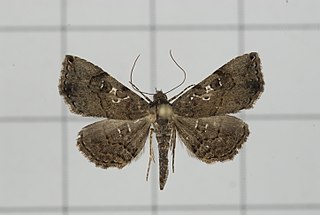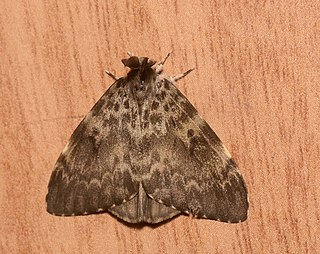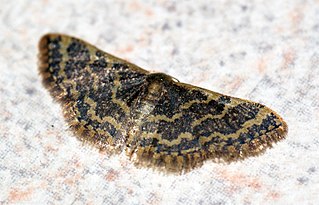Sarobela is a monotypic moth genus of the family Erebidae described by Turner in 1936. Its only species, Sarobela litterata, was first described by Pagenstecher in 1888. It is found in Sri Lanka, Hong Kong, the Philippines, Taiwan, Myanmar, the Andaman Islands, Sumatra, Sulawesi, New Guinea, Borneo and Australia.

Tephriopis is a monotypic moth genus of the family Erebidae. Its only species, Tephriopis divulsa, was first described by Francis Walker in 1865.
Pamphlebia is a monotypic moth genus in the family Geometridae described by Warren in 1897. Its only species, Pamphlebia rubrolimbraria, was first described by Achille Guenée in 1857. It is found in Sri Lanka, Borneo, Indonesia, Taiwan and Australia.

Rhesala imparata is a moth of the family Erebidae first described by Francis Walker in 1865. It is sometimes referred to as an Albizia defoliator. It is found in Sri Lanka, India, Taiwan, Singapore and Borneo.
Euproctis fulvipuncta is a moth of the family Erebidae first described by George Hampson in 1893. It is found in India and Sri Lanka.

Lymantria ampla is a moth of the family Erebidae first described by Francis Walker in 1855. It is found in India and Sri Lanka.

Eucyclodes semialba is a moth of the family Geometridae first described by Francis Walker in 1861. It is found in Sri Lanka, the north-east Himalayas of India, Myanmar and Sundaland.

Idaea purpurea is a moth of the family Geometridae first described by George Hampson in 1891. It is found in India, Sri Lanka, Taiwan, the Andaman Islands, Peninsular Malaysia and Borneo.
Metorthocheilus emarginata, or Chundana emarginata, is a moth of the family Uraniidae first described by George Hampson in 1891. It is found in the Indian subregion, Sri Lanka, Taiwan, Borneo, Java and Seram.
Cryptoblabes ephestialis is a moth of the family Pyralidae first described by George Hampson in 1903. It is found in India and Sri Lanka. The caterpillar is a pest on Ricinus communis.
Phycita eulepidella is a moth of the family Pyralidae first described by George Hampson in 1896. It is found in western Malaysia, Australia and probably in Sri Lanka.

Prasinoxena metaleuca is a moth of the family Pyralidae first described by George Hampson in 1912. It is found in Thailand, western Malaysia and Sri Lanka.
Phycidopsis albovittata is a moth of the family Notodontidae first described by George Hampson in 1893. It is found in Sri Lanka, India, Sundaland, Luzon in the Philippines and Sulawesi.
Naranga diffusa, the rice green semilooper, is a moth of the family Noctuidae. The species was first described by Francis Walker in 1865. It is found in many agricultural based countries such as Bangladesh, India, Sri Lanka, China, Hong Kong, Iran, Japan, the Korean Peninsula, Malaysia, Myanmar, the Philippines, Thailand, Taiwan and Vietnam.
Stenopterygia subcurva is a moth of the family Noctuidae first described by Francis Walker in 1857. It is found in Sri Lanka.

Rivula basalis is a moth of the family Erebidae first described by George Hampson in 1891. It is found in South India, Sri Lanka, Indo-China, Thailand, South China, Taiwan, Java, Bali and Borneo.
Hypena assimilis, is a moth of the family Erebidae first described by George Hampson in 1891. It is found in India, Sri Lanka and Taiwan.
Birthama obliquifascia is a moth of the family Limacodidae first described by George Hampson in 1893. It is found in Sri Lanka, and India.
Earias luteolaria is a moth of the family Nolidae first described by George Hampson in 1891. It is found in India, Sri Lanka, Borneo, Hong Kong and Australia.
Spatulifimbria is a genus of stinging cup moths described by George Hampson in 1893.





